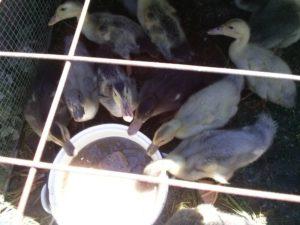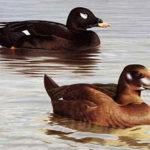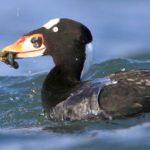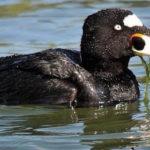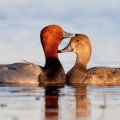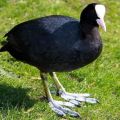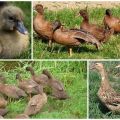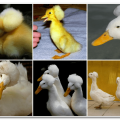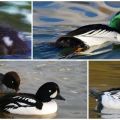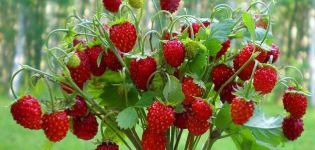Description and habitat of sad ducks, what the scooter eats and the nature of the bird
In Eurasia, the northern regions of America and Africa, the scooper lives - a rare duck, the largest representative of wild ducks. Once scoops were a popular commercial species, valued for fatty meat and high-quality down, suitable for long-term exploitation, which seriously affected their numbers. Today the species is protected by law, which should contribute to the restoration of the population.
Turpan duck appearance
The appearance of the turpan is mourning, ornithologists and hunters call the bird a sad duck. The physique is large, dense and fleshy, the head is large, the neck is long.
The external characteristics of males and females are shown in the table.
| Parameter | Male | Female |
| eyes | pale gray, almost white, in combination with the dark coloring of the feathers give the bird a mournful and sad look, white spots are visible under the eyes | grayish blue, no white spots |
| beak | short, flattened, with large and noticeable nostrils, black from the edge to the nostrils, then orange to the base with a black edging, at the base a pronounced hump | longer, black-gray, no hump |
| paws | short, with thick bones, deep red, close to the tail, wide webbing between the toes | yellow-orange, less wide membranes |
| color | deep black, with a bluish tint, white flight feathers on the sides form the so-called "mirrors" | brown with specks, flight feathers also form white "mirrors" |
| weight | up to 1.5 kg | up to 1.2 kg |
| body length | 52-58 cm | 50-55 cm |
| vote | unpleasant squeaky quack, complemented by wheezing and hissing, sometimes similar to crow's croaking and sighs with clicking | bursting, hoarse-hissing quack |
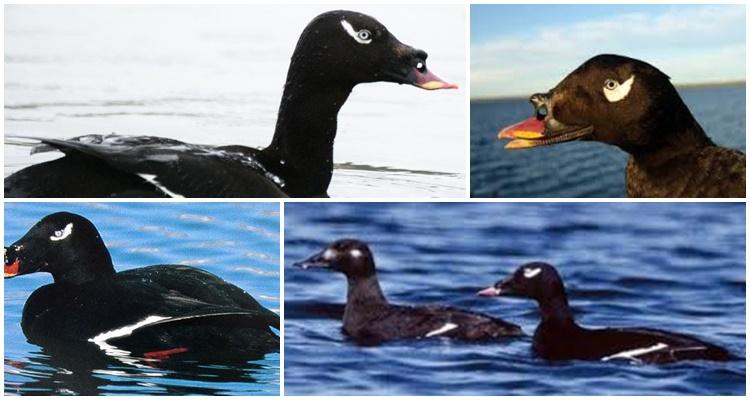
The genus turpan is divided into several species, similar anatomically and in appearance, in general, fit into the description indicated in the table. The species differ from the common turpan only in small nuances of appearance and range:
- Hump-nosed scooter. In males, the black plumage is iridescent, blue-violet and green shades are noticeable. White spots under the eyes are larger, cover the back of the head. The name is due to wider nostrils and a convex hump. The original area is taiga lakes.
- Spotted scooter. A small duck weighing about 1 kg. The peculiarity of the appearance is the color of the beak: white spots and red patterns on a black base. The voice of the birds is a quiet quack with a whistle. Habitat - lakes in Canada, northern USA, coniferous forests of Alaska.
- Singa (black scooper). The duck weighs a maximum of 1.3 kg. The beak is decorated with a yellow spot. The tail is long, with a pointed end. There are no white "mirrors" on the sides. In the cold season, both drakes and females are dark gray-brown. With the arrival of spring, males put on a black-black outfit.The area covers Eurasia from the British to the Kuril Islands, stretching from Scandinavia in the north to the Mediterranean coast of Africa in the south.
Habitat and lifestyle
The scoop duck prefers to settle on lakes surrounded by mountains and coniferous forests. A significant part of the population is sedentary in the Georgian and Armenian reservoirs. Winter is spent in regions with a temperate climate; from the northern nesting sites they fly away at the end of October and November. The departure begins later than that of other wild waterfowl species, and the return to nesting sites is noted in May, when the northern reservoirs are freed from the ice blanket.
Duck scooter nests in small reservoirs. During the migratory period, birds can be seen on the rivers. Movement on water is agile and swift, a duck swims with a protruding chest and a raised head.
Bird character
Despite the gloomy plumage, the duck is calm, non-aggressive, not prone to conflict with other feathered species. Turpans are careful, they never come close to human habitation.
The duck obtains food in the water, dexterously dives, and can dive to a depth of 10 m, hold out there for up to a minute. But scoops fly hard, leisurely, take off with effort from the water surface, in flight they keep close to the earth's surface.
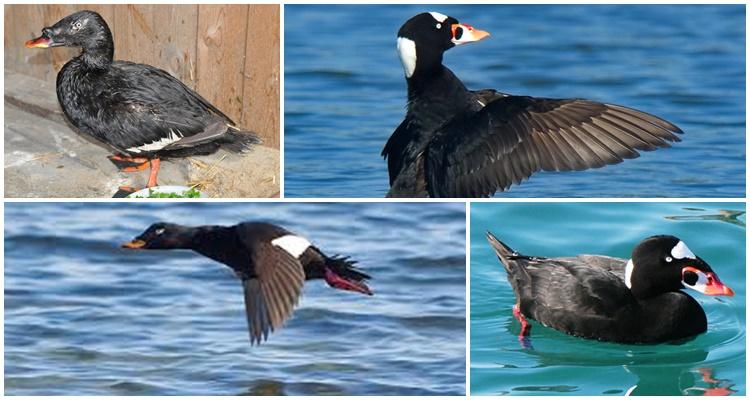
What does it eat?
Turpan main food:
- small fish;
- shellfish;
- underwater vegetation;
- insects and larvae.
That is, the scooped duck is omnivorous, it consumes both plant and animal food. When hunting under water, the duck swims remarkably, paddling not only with paws with wide membranes, but also with spread wings. When food runs out at the feeding area, scoops wander, fly over to another feeding area.
Duck breeding
Duck pairs form in late winter or early spring. Birds arrive at nesting sites in pairs. If during the flight the females fight off the flock, then the drakes slow down and wait for them. Group current. To care for females, males surround them. The drake dives under the water to get close to the selected female unnoticed. The next day, the fertilized duck circles low above the ground, quacking loudly, thereby announcing that it is going to lay eggs. The nest is insulated with its own down, so it looks shabby during the laying period.
The duck builds a nest right on the ground near the water. Quite often a scooper's nest can be seen in a colony of gulls. During the season, the duck makes one clutch - in the second half of June, sits on it for about a month. The number of eggs is not the same for different types of scoopers, but, on average, there are 7 of them. The eggs are oval, white or light beige. The hatching chicks are almost naked, weighing up to 55 g.
Due to the late clutch, the ducklings are still quite small by the beginning of August. Males do not stay with females for a long time, they fly away to the place of molting. Due to the poor development of the maternal instinct, females also leave young animals early, reunite with males a few days after the chicks hatch. And the young have to survive and feed on their own.
Many chicks die from hunger and predators, some manage to catch the offspring of other waterfowl species.
At the end of October, the surviving young flocks into flocks, preparing to fly south. There are no old ducks in the flocks, as they flew to the moulting site earlier. But young scooters are well oriented in flight, do not get lost on the way to the wintering place.
Life span
Survival for scooters is not easy because of predators and other dangers of wildlife, but also because of poaching. Few individuals survive to adulthood. Life expectancy is 13 years.
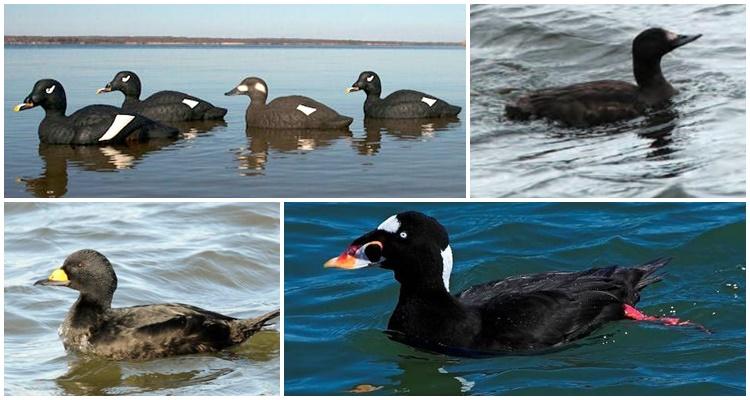
Conservation status
Turpan has long been hunted by the peoples of the north. The hunting season began at the end of May and June, when the birds that returned to their homeland circled low over the water bodies, preparing to nest in the chosen place.
Turpan is a cautious but stupid duck. It is not difficult for a hunter to lure her. Thus, northern earners bleated like lambs, and these sounds really attracted birds. Western hunters acted more cunningly: they made a stuffed turpan, carried it to the reservoir, and the birds took the fake for a living relative. It was customary among northern peoples to store dead carcasses directly on the icy surface of the reservoir, covering it with moss.
Today hunting for scoops is prohibited, the species is listed in the Red Book as endangered, in need of protection. The number of birds around the world does not exceed 4.5 thousand individuals. Although, thanks to the conservation status, the number of individuals has stabilized, ornithologists hope that it will begin to increase.
